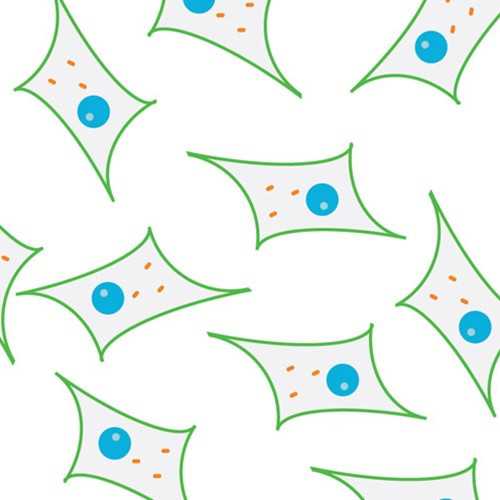Murine Osteoblast to Osteocyte-like Cell Line MLO-A5
MLO-A5 cell line is a model for the osteoblast to osteocyte differentiation process, the mineralization process, and the effects of mechanical loading on biomineralization.
Highlights:
- Derived from a transgenic mouse in which the immortalizing T-antigen was expressed under control of the osteocalcin promoter
- Express markers of the late osteoblast such as extremely high alkaline phosphatase, bone sialoprotein, PTH type 1 receptors, and osteocalcin
- Rapidly mineralize in sheets, not nodules
- Forms a “honeycomb”-like mineralized matrix within 7–9 days of culture
Osteocytes are the most abundant bone cells in the body but also the most challenging to study because they are embedded in a mineralized matrix making them to difficult to isolate. This cell line MLO-A5 make it easier to study osteocyte function.
From the laboratory of Lynda Bonewald, PhD, University of Missouri - Kansas City.
MLO-A5 cell line is a model for the osteoblast to osteocyte differentiation process, the mineralization process, and the effects of mechanical loading on biomineralization.
Highlights:
- Derived from a transgenic mouse in which the immortalizing T-antigen was expressed under control of the osteocalcin promoter
- Express markers of the late osteoblast such as extremely high alkaline phosphatase, bone sialoprotein, PTH type 1 receptors, and osteocalcin
- Rapidly mineralize in sheets, not nodules
- Forms a “honeycomb”-like mineralized matrix within 7–9 days of culture
Osteocytes are the most abundant bone cells in the body but also the most challenging to study because they are embedded in a mineralized matrix making them to difficult to isolate. This cell line MLO-A5 make it easier to study osteocyte function.
From the laboratory of Lynda Bonewald, PhD, University of Missouri - Kansas City.
Specifications
| Product Type: | Cell Line |
| Name: | MLO-A5 |
| Cell Type: | Postosteoblast/preosteocyte |
| Accession ID: | CVCL_0P24 |
| Morphology: | Adherent osteoblast-like cell; honeycomb-like mineralized matrix within 7-9 days of culture |
| Organism: | Mouse |
| Biosafety Level: | I |
| Growth Conditions: |
Proliferation medium: AlphaMEM (containing L-glutamine and deoxyribonucleosides); supplemented with 5% FBS and 5% CS, both heat-inactivated; penicillin-streptomycin at 100U/ml-100ug/ml Differentiation medium: AlphaMEM (L-glutamine and deoxyribonucleosides); supplemented with 10% FBS; penicillin-streptomycin at 100U/ml-100ug/ml; approximately 100µg/ml Ascorbic Acid and 4mM β-glycerophosphate (see Comments). Grown on dishes coated with [0.15 mg/ml] rat tail type I collagen. |
| Subculturing: | Maintain stock cultures in proliferation medium under subconfluent conditions on collagen coated plates at 37°C and at 5% CO 2. Passage at ~ 1:10 to 1:20 dilution using 0.05% Trypsin/0.53 mM EDTA every 3-4 days (see Rosser J. et al. Methods Mol Biol. 2012;816:67-81) |
| Cryopreservation: | 60% alpha-MEM, 30% FBS, 10% DMSO, at 1 × 10 6 cells/ml/cryovial (see Rosser J. et al. Methods Mol Biol. 2012;816:67-81) |
| Storage: | Liquid nitrogen |
| Shipped: | Dry ice |
Provider
From the laboratory of Lynda Bonewald, PhD, University of Missouri - Kansas City.
Comments
- When first starting these cells, centrifuge at approx. 1,000 rpm, for 5–10 min. Aspirate media, gently resuspend and plate the cell pellet in media containing 5% FBS and 5% CS. This higher amount of serum, 10% total, is useful to give the cells an extra boost. The next day, check the viability of the cells. If there are a lot of floating “dead” cells, change the medium.
- For mineralization studies, plate the cells on collagen coated plates at ~3.5 x 10^4 cells/cm2 in proliferation medium; the cells should be confluent ~2 days.
- At confluence (Day 0), switch to the differentiation medium, adding the ascorbic acid and β-glycerophosphate fresh to the medium on the day of feeding.
- Change the differentiation media every 2-3 days. The collagen fibrils start forming into a swirling, honeycomb pattern 4-6 days after the addition of β -GP and ascorbic acid.
- Optimal mineralization is usually found around Day 10-14.
References
- Kato Y, Windle J,Koop B, Qiao M, Bonewald L. Establishment of an osteocyte-like cell line, MLO-Y4 J Bone Min. Res. 12:2014-2023, 1997.
- Kato, Y, Boskey, A, Spevak, L, Dallas, M, Hori, M, Bonewald, LF, Establishment of an Osteoid Pre-Osteocyte like cell, MLO-A5, that spontaneously mineralizes in culture without the addition of beta-glycerol phosphate and ascorbic acid. J. Bone Min. Res. 16:1622-1633, 2001.
- A. Sittichockechaiwut, A.M. Scutt, A.J. Ryan, L.M. Bonewald, G.C. Reilly: Use of rapidly mineralising osteoblasts and short periods of mechanical loading to accelerate matrix maturation in 3D scaffolds. Bone 44: 822-829. 2009.
- H. Morris, C. Reed, J. Haycock, G.C. Reilly. Osteoblast signalling and matrix responses to dynamic flow. Proceedings of the Institution of Mechanical Engineers: Part H Journal of Engineering in Medicine. 224: 1509-1521. 2010.
- Rosser J, Bonewald LF. Studying osteocyte function using the cell lines MLO-Y4 and MLO-A5. Methods Mol Biol. 2012;816:67-81.
- R. M. Delaine-Smith, S. MacNeil G.C. Reilly. Matrix production and collagen structure are enhanced in two types of osteogenic progenitor cells by a simple fluid shear stress stimulus. eCells and Materials. 24: 162-174. 2012.
- R. M. Delaine-Smith, A. Sittichokechaiwut, G. C. Reilly. Primary cilia respond to fluid shear stress and mediate flow-induced calcium deposition in osteoblasts. FASEB Journal. 28: 430-439. 2014.
- Khalid S, Yamazaki H, Socorro M, Monier D, Beniash E, Napierala D. Reactive oxygen species (ROS) generation as an underlying mechanism of inorganic phosphate (Pi)-induced mineralization of osteogenic cells. Free Radic Biol Med. 2020 Jun;153:103-111. View article
- Delaine-Smith RM, Hann AJ, Green NH, Reilly GC. Electrospun Fiber Alignment Guides Osteogenesis and Matrix Organization Differentially in Two Different Osteogenic Cell Types. Front Bioeng Biotechnol. 2021 Oct 25;9:672959. doi: 10.3389/fbioe.2021.672959. PMID: 34760876; PMCID: PMC8573409.
If you publish research with this product, please let us know so we can cite your paper.


